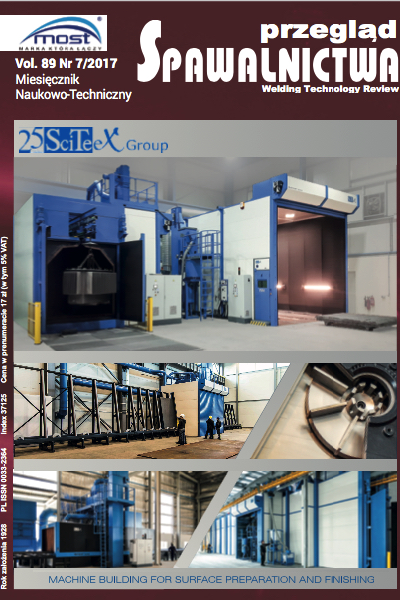Hardening tools for hot forging flanges with a neck
Main Article Content
Abstract
In the forging of steel anges with neck, where the forging temperature is around 1150 °C, it places extremely high demands on the dies. Abrasive wear, thermal fatigue, adhesion, etc. are very important parameters affecting the durability of forging tools. Nitriding and CVD coatings are often used to make wear resistance better. These processes, however, are not intended to be used as regenerative methods for increasing the suitability of work tools. Welding technologies come with help. Preventive as well as regenerative repairs have great applicability in the forging industry.
in polish
Napawanie regeneracyjne narzędzi do kucia na gorąco kołnierzy z szyjką
Kucie kołnierzy stalowych z szyjką, gdzie temperatura odkuwki wynosi ok. 1150 °C stawia niezwykle wysokie wymagania matrycom. Odporność na zużycie ścierne, zmęczenie cieplne, adhezyjne itp. są bardzo istotnymi parametrami mającymi wpływ na trwałość narzędzi kuźniczych. Azotowanie dyfuzyjne oraz powłoki CVD są często stosowane w celu zwiększenia trwałości narzędzi kuźniczych. Procesy te jednak nie znajdują zastosowania jako regeneracyjne metody zwiększania przydatności narzędzi do pracy. Z pomocą przychodzą technologie spawalnicze. Napawanie prewencyjne podobnie jak regeneracyjne mają duże zastosowanie w przemyśle kuźniczym [1÷5].
Downloads
Article Details
Creative Commons CC BY 4.0 https://creativecommons.org/licenses/by/4.0/
Welding Technology Review (WTR) articles are published open access under a CC BY licence (Creative Commons Attribution 4.0 International licence). The CC BY licence is the most open licence available and considered the industry 'gold standard' for open access; it is also preferred by many funders. This licence allows readers to copy and redistribute the material in any medium or format, and to alter, transform, or build upon the material, including for commercial use, providing the original author is credited.
References
Altan T.: Cold and hot forging fundamentals and application, ASM Internation, Ohio, 2005.
Anders P, Hogmark S, Bergström J.: Simulation and evaluation of thermal fatigue cracking of hot work tool steels, International Journal of Fatigue 2004 (10), pp. 1095-1107.
Archard J.F.: Contact and rubbing of at surfaces, Journal of Applied Physics, 24, pp. 981-988,1953.
Asm metals handbook volume 14, Forming and forging, pp. 337-338.
Bariani P. F., Dal Negro T., Fioretti M.: Joint use of physical and numerical simulation techniques in predicting process parameters evolution and microstructure in forging Nimonic 80A turbine blades, Proceedings of the 2nd Esaform, Guimares, Portugal, 1999.
Barrau O., Boher C., Vergne C., Rezai-Aria F.: Investigation of Friction and Wear Mechanism of Hot Forging Tool Steels, 6th Int. Tooling Conference, Karlstadt 2002.
Barron R.F.: How cryogenic treatment controls wear, 21st InterPlant Tool and Gage Conference. Shreveport, LA, USA,1982. (wg ASM Handbook, t.4, pp. 205.
Barylski A., Deja M.: Surface atness control in singl plate lapping [onli-ne], [dostęp 10 maj 2013] Dostępny w internecie: <http://home.mit.bme. hu/~kollar/IMEKO-proc les-for-web/congresses/WC-16th-Wien-2000/ Papers/Topic%2002/Barylski.PDF>
Basqiun O.H.: The exponential law in endurance tests, Am. Soc. Test. Mater. Proc., 10; pp. 625-630.
Baumel A., Seeger T.: Material Data for Cyclic Loading, Suplement 1, Marterials Science Monographs, 61, Elsevier Science Publishers, Amsterdam 1990.
